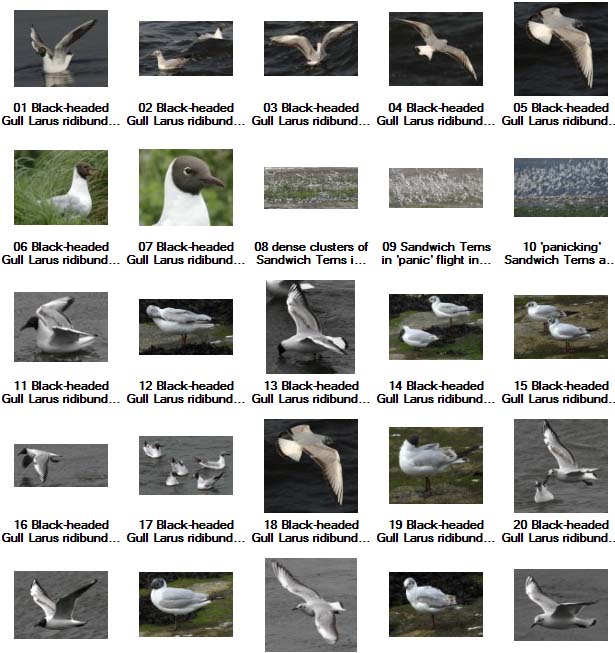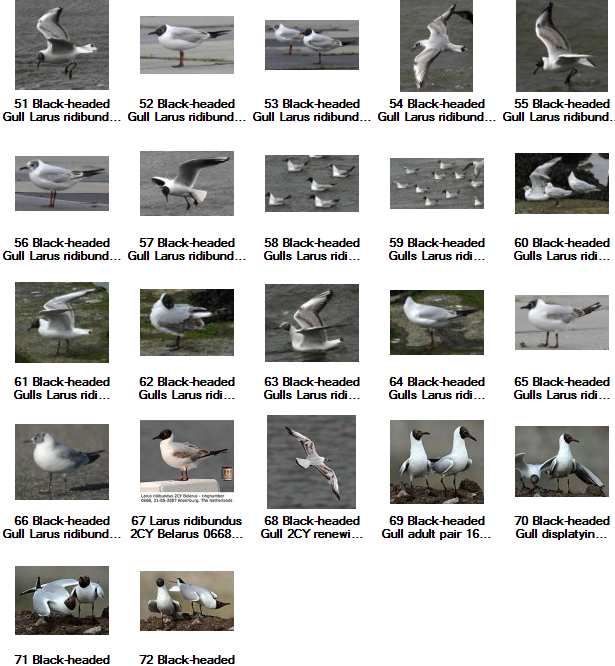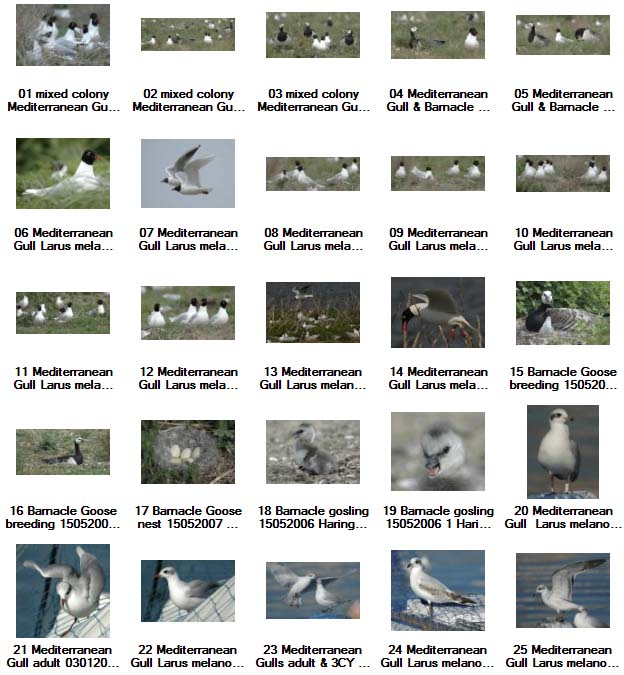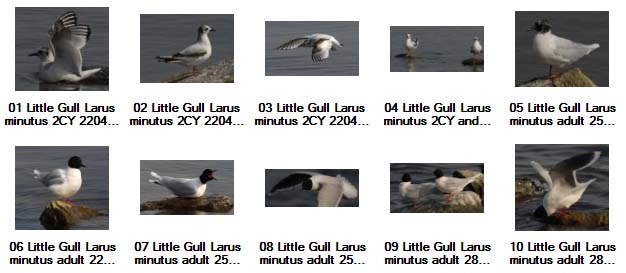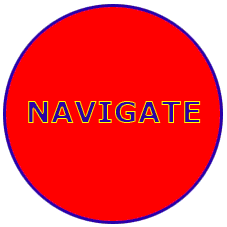

SMALL GULLS
QUICK OVERVIEW (click to next pages on the indexscreenshots below!)
![]() Black-headed Gulls are very common in the Dutch delta in all months of the year. The large colonies are a key element in the
coastal ecosystem. Sandwich Terns f.i. will only breed when there is a Black-headed Gull colony around and if so they will settle in dense clusters amidst the gulls leaving the defence to the poor gulls which will suffer great losses to marauding Herring and Lesser Black-backed Gulls. Mediterranean Gulls, Barnacle Geese, Red-breasted Mergansers, Tufted Ducks and Gadwalls very much depend on the protection of the Black-headeds and even Avocets and Common Terns who can perfectly fend for themselves like the Black-headeds to serve on the front line.
Black-headed Gulls are very common in the Dutch delta in all months of the year. The large colonies are a key element in the
coastal ecosystem. Sandwich Terns f.i. will only breed when there is a Black-headed Gull colony around and if so they will settle in dense clusters amidst the gulls leaving the defence to the poor gulls which will suffer great losses to marauding Herring and Lesser Black-backed Gulls. Mediterranean Gulls, Barnacle Geese, Red-breasted Mergansers, Tufted Ducks and Gadwalls very much depend on the protection of the Black-headeds and even Avocets and Common Terns who can perfectly fend for themselves like the Black-headeds to serve on the front line. ![]()
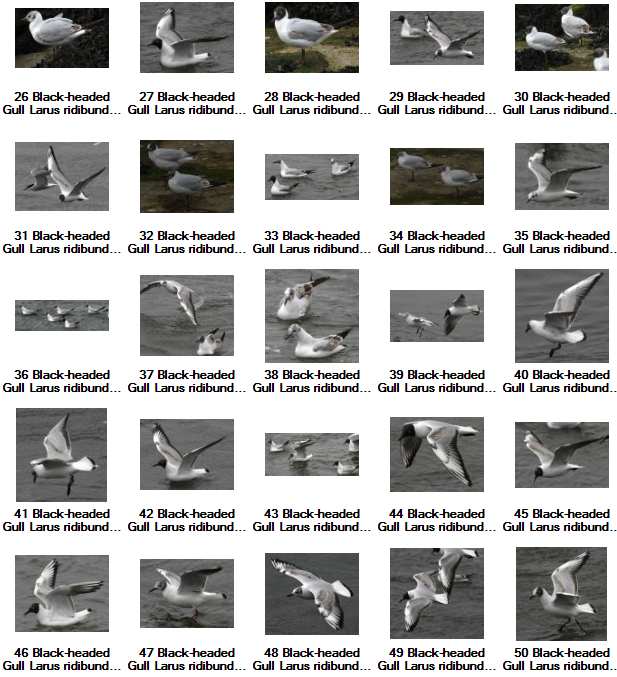
Smal
![]() 1-blackheadedgulls-
1-blackheadedgulls-
![]() 2-bonapartegulls-
2-bonapartegulls-
![]() 3-mediterraneangulls-
3-mediterraneangulls-
![]() 4-littlegulls
4-littlegulls
![]() 5-franklin'sgulls
5-franklin'sgulls
![]() Bonaparte's Gull Larus philadelphia: On 6th May 2007 I found a 2nd calendar year Bonaparte's Gull in the western part of the Port of Rotterdam. It was the third time I found this species in late spring in the SW part of The Netherlands. Increasingly species of New World origin are seen during spring at this latitude. I speculate that these birds strayed to North Africa and southern Europe in autumn and migrate northward in spring and eventually returning to Canada via the shortest route crossing the North Atlantic. A summer plumaged adult similar to the one I found on 6th May 2004 (sorry for the very vague pictures!) was seen a week later in NW England fitting the speculation. It is interesting to see that the legs of this year's immature bird are darker, reddish-brown instead of pink, than during winter, I have not seen this mentioned before but a 1st summer bird photographed 25th May 1984 in California by Harry J.Lehto (plate 670 on p.472 in Gulls by Malling Olsen & Larsson) shows the same dark legs.
Bonaparte's Gull Larus philadelphia: On 6th May 2007 I found a 2nd calendar year Bonaparte's Gull in the western part of the Port of Rotterdam. It was the third time I found this species in late spring in the SW part of The Netherlands. Increasingly species of New World origin are seen during spring at this latitude. I speculate that these birds strayed to North Africa and southern Europe in autumn and migrate northward in spring and eventually returning to Canada via the shortest route crossing the North Atlantic. A summer plumaged adult similar to the one I found on 6th May 2004 (sorry for the very vague pictures!) was seen a week later in NW England fitting the speculation. It is interesting to see that the legs of this year's immature bird are darker, reddish-brown instead of pink, than during winter, I have not seen this mentioned before but a 1st summer bird photographed 25th May 1984 in California by Harry J.Lehto (plate 670 on p.472 in Gulls by Malling Olsen & Larsson) shows the same dark legs. ![]()
![]() 1-blackheadedgulls-
1-blackheadedgulls-
![]() 2-bonapartegulls-
2-bonapartegulls-
![]() 3-mediterraneangulls-
3-mediterraneangulls-
![]() 4-littlegulls
4-littlegulls
![]() 5-franklin'sgulls
5-franklin'sgulls
![]() Mediterranean Gull
Larus melanocephalus or where North meets South! During the ninety ninetees both Mediterranean Gull
Larus melanocephalus and Barnacle Goose
Branta leucopsis began to settle in The Netherlands in ever increasing numbers and both settled quite comfortably in local Black-headed Gull colonies. The Mediterranean Gulls settle amidst the Black-headeds and when there is any danger most of them leave the colony and leave the defense and losses to the Black-headeds! Like other geese, the Barnacle's like to breed among gulls which see danger coming before they do. The Barnacle Geese have profited from the protection they got in the beginning of the fifties when their numbers were dangerously low as a result of hunting. Since then they slowly recovered but in recent decennia showed a remarkable expansion from their former stronghold on Novaya Zemlya to the north Russian coast, then to the Baltic and now some thousands breed in the SW Netherlands in the very area where the whole Russian population winters. This is the first example of an arctic species adapting quite well to sub-arctic and temperate conditions! The Mediterranean Gulls on the other hand feed exclusively inland on intensely manured fields during their stay in Holland thus benefiting from industrial pig-farming.
Mediterranean Gull
Larus melanocephalus or where North meets South! During the ninety ninetees both Mediterranean Gull
Larus melanocephalus and Barnacle Goose
Branta leucopsis began to settle in The Netherlands in ever increasing numbers and both settled quite comfortably in local Black-headed Gull colonies. The Mediterranean Gulls settle amidst the Black-headeds and when there is any danger most of them leave the colony and leave the defense and losses to the Black-headeds! Like other geese, the Barnacle's like to breed among gulls which see danger coming before they do. The Barnacle Geese have profited from the protection they got in the beginning of the fifties when their numbers were dangerously low as a result of hunting. Since then they slowly recovered but in recent decennia showed a remarkable expansion from their former stronghold on Novaya Zemlya to the north Russian coast, then to the Baltic and now some thousands breed in the SW Netherlands in the very area where the whole Russian population winters. This is the first example of an arctic species adapting quite well to sub-arctic and temperate conditions! The Mediterranean Gulls on the other hand feed exclusively inland on intensely manured fields during their stay in Holland thus benefiting from industrial pig-farming. ![]()
![]() Little Gull Larus minutus: In spring the occurrence of Little Gulls in the Rhine-Meuse delta of the SW Netherlands is highly dependant of strong NE winds in April and May. The strong easterlies force the migratory stream of Little Gulls through the middle of Europe westwards. The gulls while on their way towards the breeding areas in Eastern Europe may then reach the large fresh water lakes formed after the estuary was cut off from the North Sea. The gulls feed on chironomidae in the company of marsh terns. In some years one or two pairs of these gorgeous birds remain and nest on the edge of Black-headed Gull colonies.
Little Gull Larus minutus: In spring the occurrence of Little Gulls in the Rhine-Meuse delta of the SW Netherlands is highly dependant of strong NE winds in April and May. The strong easterlies force the migratory stream of Little Gulls through the middle of Europe westwards. The gulls while on their way towards the breeding areas in Eastern Europe may then reach the large fresh water lakes formed after the estuary was cut off from the North Sea. The gulls feed on chironomidae in the company of marsh terns. In some years one or two pairs of these gorgeous birds remain and nest on the edge of Black-headed Gull colonies. ![]()
![]() 1-blackheadedgulls-
1-blackheadedgulls-
![]() 2-bonapartegulls-
2-bonapartegulls-
![]() 3-mediterraneangulls-
3-mediterraneangulls-
![]() 4-littlegulls
4-littlegulls
![]() 5-franklin'sgulls
5-franklin'sgulls
![]() Franklin's Gull
Franklin's Gull

